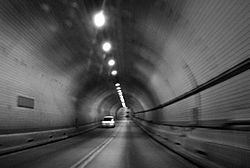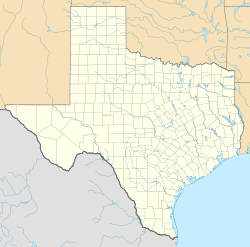Washburn Tunnel facts for kids
 |
|
| Overview | |
|---|---|
| Location | Underneath the Houston Ship Channel |
| Status | Open |
| Route | Federal Road |
| Operation | |
| Work begun | 1945 |
| Operator | Harris County Toll Road Authority |
| Toll | Free |
| Technical | |
| Length | 3,791 ft (1,155 m) |
| Number of lanes | 2 |
|
Washburn Tunnel
|
|
| Location | Harris County, Texas, USA |
| Architectural style | Various |
| NRHP reference No. | 08000316 |
| Added to NRHP | April 16, 2008 |
The Washburn Tunnel is a special underwater road for cars and trucks. It connects two towns near Houston, Texas: Galena Park and Pasadena. This tunnel goes under the Houston Ship Channel.
It was finished in 1950 and was named after Harry L. Washburn, who worked for Harris County, Texas. The Washburn Tunnel was the first and largest tunnel in the Southern United States that didn't charge a fee to use it.
Contents
What is the Washburn Tunnel?
The Washburn Tunnel is a two-lane tunnel that helps people travel between towns. It goes north and south under the busy Houston Ship Channel. This channel is a waterway for ships.
How Was the Tunnel Built?
The Merritt Chapman and Scott Corporation built the tunnel. The project cost about $7 million back then. Building an underwater tunnel is a big job!
First, workers had to dig a deep trench in the ground. This trench was about 90 ft (27 m) long and 40 ft (12 m) wide. Then, large parts of the tunnel were carefully lowered into this trench. They were locked into place about 85 feet underwater. Finally, the inside of the tunnel was finished with things like tiles.
How Does the Tunnel Work?
The Washburn Tunnel is the only underwater vehicle tunnel still open in Texas. Another tunnel, the Baytown Tunnel, was replaced by a bridge in 1995.
The Washburn Tunnel has one main tube. It is about 895 meters (2,909 feet) long. The road inside slopes down towards the middle and then up towards each exit. This slope is called a "grade."
Keeping the Air Clean
The tunnel has a special system to keep the air fresh. Three large fans, called Westinghouse Sturtevant blower fans, are in a tower at the north entrance. These fans work automatically. They help remove harmful gases like carbon monoxide from the air. This makes sure the air is safe to breathe inside the tunnel.
Power and Lights
If the electricity goes out, a backup generator turns on. This generator powers some of the lights in the tunnel. Every twelfth light is connected to this generator.
The lights at the tunnel's entrances are much brighter than the lights inside. This helps drivers' eyes adjust. It stops them from being temporarily blinded when they enter the dark tunnel.
Staying Dry
Pumps are located under the road surface. These pumps collect any water that gets into the tunnel. They then drain the water back into the ship channel. This keeps the tunnel from flooding. Before Hurricane Ike in 2008, the tunnel had never been flooded.
How Does the Washburn Tunnel Help People?
The Washburn Tunnel is one of five ways to cross the Houston Ship Channel by vehicle. The other crossings are:
- The Sidney Sherman Bridge (also known as the I-610 Bridge)
- The Sam Houston Ship Channel Bridge (also known as the Beltway 8 Bridge)
- The Fred Hartman Bridge, which connects La Porte, Texas and Baytown, Texas
- The Lynchburg Ferry, which carries cars across the water.
The Washburn Tunnel is special because it is open 24 hours a day. It helps people get where they need to go at any time.
Recognized as Important History
On April 16, 2008, the Washburn Tunnel was added to the National Register of Historic Places. This means it is an important historical site in the United States.
Who Manages the Tunnel Now?
Since March 1, 2020, the Harris County Toll Road Authority (HCTRA) has managed the Washburn Tunnel. They also manage the Lynchburg Ferry. Even though HCTRA usually handles roads that charge tolls, they have no plans to add tolls to the Washburn Tunnel or the Lynchburg Ferry.
HCTRA plans to make improvements to both the tunnel and the ferry. This includes needed repairs and upgrades to make them work even better.
Key Facts About the Washburn Tunnel
Here are some interesting facts and figures about the Washburn Tunnel:
- Total Cost (1950): $7,683,915
- Total Length: 3,791 feet
- Distance between Entrances (Portals): 2,936 feet
- Length of the Main Tube Section: 1,500 feet
- Roadway Width: 22 feet (this is how wide the road is inside)
- Headroom (each lane): 13 feet (how much space there is from the road to the ceiling)
- Headroom (center Lane): 18 feet
- Inside Diameter of Tubes: 32 feet (how wide the tunnel tube is on the inside)
- Outside Diameter of Tubes: 38 feet (how wide the tunnel tube is on the outside)
- Maximum Grade: 6% (the steepest part of the slope inside)
- Maximum Depth (Water to top of tunnel): 45 feet
- Maximum Depth (Water to roadway): 68 feet
- Maximum Depth (Water to bottom of tunnel): 80 feet
- Number of Fans: 3
- Maximum Ventilation: 760,000 cubic feet per minute (cfm)
- Complete Air Exchange: The air inside the tunnel can be completely replaced in just 2 minutes!
Images for kids
See also
- Washburn Tunnel in the Structurae database
 In Spanish: Túnel Washburn para niños
In Spanish: Túnel Washburn para niños



